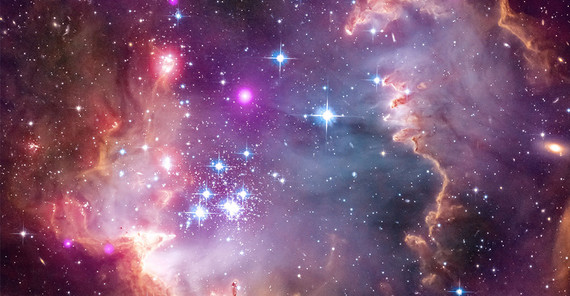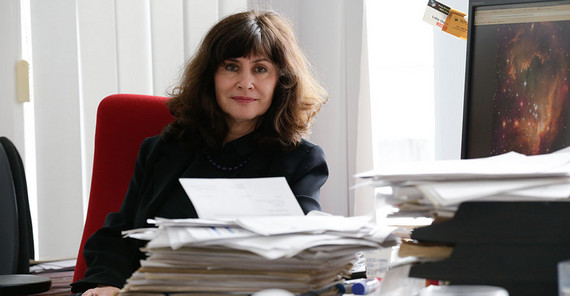During our interview, an important message from the Hubble Space Telescope comes in. “I’m looking at the star SST2011-J081929.00+704219.3 with Cosmic Origins Spectrograph for Dr. Lidia Oskinova.” Exactly at this moment, Hubble is looking at one of Oskinova’s research objects. Only two hours later, the telescope is already pointed at another area of space. On spacetelescopelive.org, everyone can watch the current observations of the world’s most famous telescope orbiting Earth.
Computer models and gender bias in astronomy
Oskinova’s research projects all concentrate on a particular type of star that emits X-rays and has more than ten times the mass of our Sun. “These so-called massive stars are rather rare in our galaxy. However, since they have more energy and are brighter than other stars, they dominate our night sky,” Oskinova says. At the end of their lives, their cores collapse due to their large mass and form very high-density neutron stars or even black holes. “We only measure the light, but we want to understand what the stars are made of and what they do to their surrounding area. To this end, we use the PoWRCode.” Wolf-Rainer Hamann, at the time professor of astronomy, developed the Potsdam Wolf-Rayet Models (PoWR) in the 1990s. They have since become an internationally acclaimed and efficient computer code “made in Potsdam”.
But before any investigation, it is necessary to obtain observing time for the space telescopes. And this is not as easy as it seems: For a few hours of observing time, you must submit a comprehensive, scientifically sound observing proposal, which is reviewed by an independent committee of experts. The proposal must convincingly explain what is to be observed and why. Only 10% - 20% of all proposals are approved. “Evaluations of all proposals of the last few years have shown that it is much more difficult for women and also for early-career researchers to obtain observing time. For established researchers, on the other hand, the probability of approval is higher,” Oskinova says. “Since double-blind reviews have been introduced, the review process has become fairer.” The “gender bias” for the Hubble Space Telescope, for example, has been corrected and other telescope teams now want to follow suit.
Cosmic neon lights
Using the XMM-Newton X-ray telescope, Oskinova recently detected a very unusual type of star. The object with the exotic name IRAS 00500+6713 consists of a central star embedded in a circular nebula of gas with a temperature of a few million degrees and cooler dust. The nebula shines brightly in the X-ray range, specifically in neon light. Oskinova’s team is convinced that these are the remnants of two white dwarf stars that have collided. The neon-rich nebula is the material ejected in the course of this event. It has also been known for a few years that a record-breaking stellar wind emanates from the central star – with a speed of 16,000 kilometers per second! “In addition to radiation, massive stars give off streams of particles at incredibly high speeds. This causes the stars to lose a lot of mass over time,” Oskinova describes her observations. For many years, she has been working on the theory and spectroscopic analysis of stellar winds using the PoWR computer code.
X-ray vision into the future
With ESA’s XMM-Newton X-ray telescope in orbit for over 20 years, there are plans for two new astronomical instruments: ATHENA, a telescope for high-energy astrophysics, and the LISA laser interferometer, a space-based gravitational wave observatory. Gravitational waves are produced when space objects with extremely high density, such as neutron stars or black holes, merge with each other. Oskinova studies massive stars that form the precursors of these exotic objects. “Thus, there is a connection between what we observe with the naked eye in the night sky every day and the invisible gravitational waves, whose existence we can hardly imagine,” she says. Although it will take at least ten years before the missions will start, she is already looking forward to new, exciting data from the depths of space.
The Researcher
Apl.Prof. Dr. Lidia Oskinova studied astronomy at St. Petersburg University where she also earned a doctorate. Then she worked as a researcher at the University of Glasgow (Scotland). In 2002, she came to the University of Potsdam, where she was habilitated in 2013. Since 2020, Lidia Oskinova has been Professor of Astrophysics.
Mail: lida.oskinovauuni-potsdampde
This text was published in the university magazine Portal Wissen - Two 2021: Departure (PDF).


